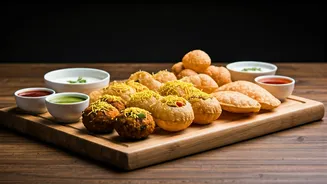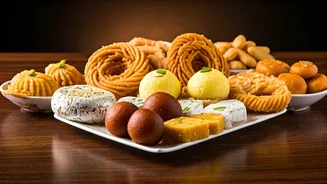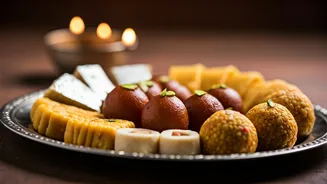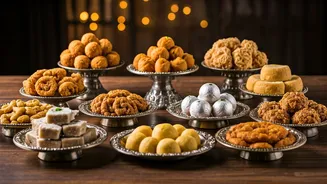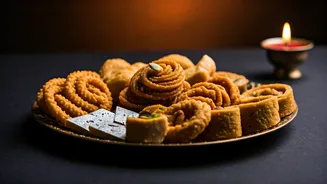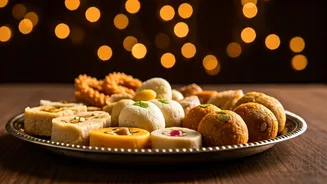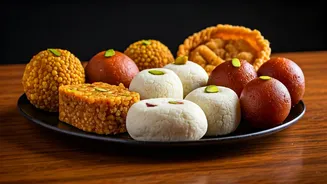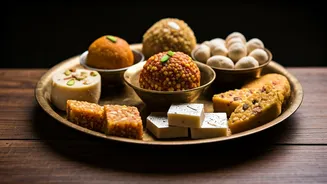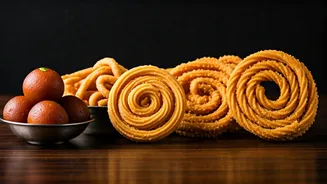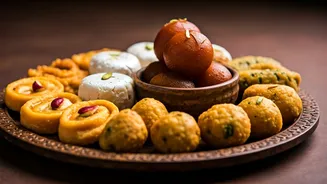Chaat Board Intro
The chaat board is an innovative approach to serving a variety of Indian street food snacks during Diwali. It departs from the conventional serving of individual
chaat items and presents them in an organized, visually appealing manner. A well-curated chaat board typically includes a selection of popular chaat items, providing a range of textures, flavors, and spice levels to satisfy diverse palates. This could feature the sweet and tangy notes of chutneys, the cooling effect of yogurt, the delightful crunch of sev, and the comforting warmth of spiced potatoes. The arrangement allows guests to customize their chaat experiences, mixing and matching ingredients according to their preferences. The presentation of the chaat board is also crucial, using platters, bowls, and decorative elements to enhance the aesthetic appeal and make it a focal point of the festive spread. The chaat board has emerged as an elegant and interactive way to offer a celebratory experience, ensuring that every guest can enjoy chaat.
Essential Components
Creating a captivating chaat board requires consideration of the fundamental components that make up the quintessential chaat experience. First, a diverse assortment of bases should be considered. These bases, which are the foundation of the chaat, could include crispy papdi, puffed puris, or even samosas, setting the stage for the addition of various toppings and fillings. The inclusion of an array of chutneys is a must-have. Tamarind chutney gives a sweet and tangy flavour, green coriander-mint chutney adds a refreshing, spicy burst, and the spicy garlic chutney enhances the overall taste. Next, a range of fillings, such as boiled potatoes seasoned with spices, chickpeas, or a mixture of lentils, is often incorporated. These add bulk and substance to the chaat, giving it its well-known texture. Adding yogurt, whether plain or lightly sweetened, is critical for a smooth and cooling element, as it contrasts well with the spices. Finally, garnish the dish with toppings and finishing touches, such as sev (thin, crispy noodles), chopped onions, fresh coriander leaves, and pomegranate seeds for texture, taste, and visual appeal. When all these components are artfully brought together, the chaat board offers a beautiful balance of flavors and a memorable sensory journey.
Chaat Board Assembly
The assembly of a chaat board is more of an art form. The key is to arrange the components in an aesthetically pleasing way. Begin by choosing a large platter or board as your canvas. Place the larger components, like papdi, puris, or samosas, as the central focal points. Arrange the chutneys, such as tamarind, mint-coriander, and garlic chutneys, in small bowls and place them around the board for easy access. Next, arrange the fillings like boiled potatoes, chickpeas, and lentils in separate sections, ensuring that they are easily accessible for layering. Add the yogurt in a small bowl or a decorative squeeze bottle, depending on how you wish to serve it. The toppings, such as sev, chopped onions, coriander leaves, and pomegranate seeds, can be placed in small, decorative bowls to create visual contrast. The secret lies in creating a layout that is both visually striking and practical. It should be designed so that it’s easy to create various chaat combinations by adding the chutneys, fillings, yogurt, and toppings. This interactive arrangement lets guests personalize their chaat experience and allows for a fun-filled Diwali celebration.
Variations & Twists
To keep the chaat board exciting, think of ways to customize and improvise. One popular variation includes regional chaat varieties. Include the likes of dahi puri, aloo tikki chaat, or even a South Indian twist with items like masala vada and medu vada. Consider the inclusion of unique chutneys. For example, a date and fig chutney can add a rich sweetness, while a roasted red pepper chutney provides a smoky touch. You can also explore different bases beyond the traditional papdi and puris. Try using mini idlis or dosas for a different texture. Adding fresh elements such as raw mango or green apple adds a refreshing crunch and brightness to the chaat board. For a more modern and international twist, incorporate ingredients like avocado or pickled vegetables to blend flavors and satisfy a variety of palates. By using these ideas, you can personalize your chaat board and make it the focal point of a delightful and memorable Diwali feast, reflecting your own creativity.
Presentation & Serving
The presentation and serving style of your chaat board are very important. Choose a board or platter that matches the festive mood, such as wooden boards, marble slabs, or colourful serving dishes, adding a touch of elegance to the table. Use small, attractive bowls and ramekins to hold chutneys, fillings, and toppings. Arrange ingredients in an orderly and visually appealing manner, contrasting colours and textures. Create visual interest by adding decorative elements like fresh flowers, candles, or small festive lights to enhance the Diwali atmosphere. When serving, make it interactive! Provide small spoons, forks, or even toothpicks for guests to assemble their chaat. To keep the flavours fresh, prepare the chutneys and fillings just before serving. For easy preparation, you can arrange all components a few hours beforehand and assemble the chaat just before the guests arrive. This strategy ensures that everything is fresh and the guests can enjoy the best of chaat, creating a joyful and memorable experience.
